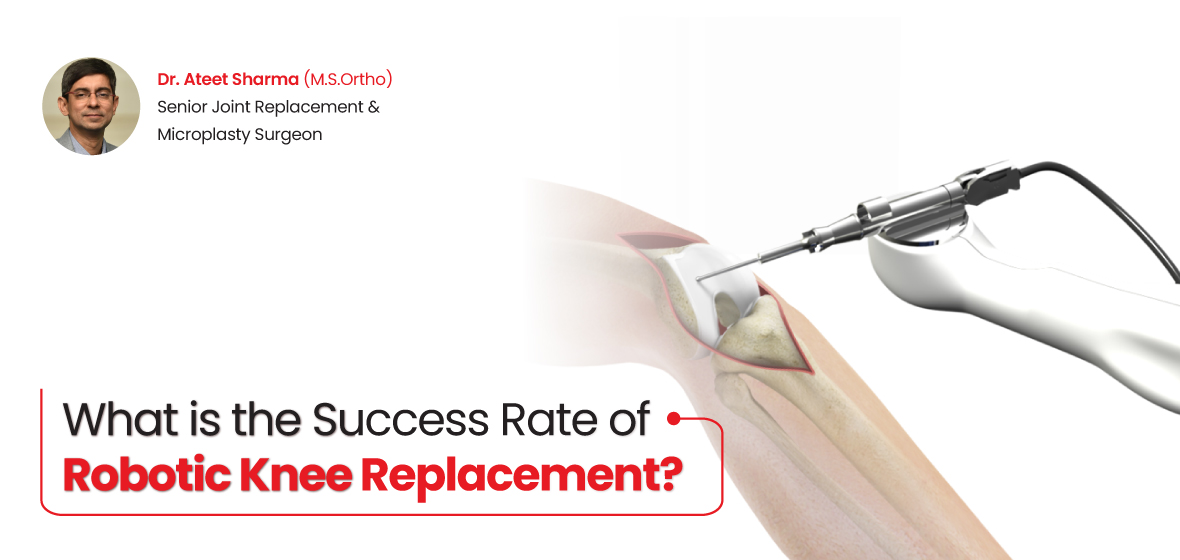
When it comes to joint pain, especially in the knees, many people suffer in silence for years. The discomfort from arthritis or injury can limit your mobility and, ultimately, your quality of life. For some, surgery is the only option to regain the ability to move freely without pain. You can visit Dr Ateet for more information and get the Best Robotic Knee Replacement Treatment in Ahmedabad.
Many technologies in orthopedics have dramatically advanced, and robotic knee replacement is one of the most exciting innovations. But how successful is it? Is it the right choice for everyone? Let’s explore the success rate of robotic knee replacement and what makes this technology stand out.

To start, we shall distinguish robotic knee replacement and get into its success rate. Robotic knee replacement, also called robotic-assisted knee replacement, is an advanced surgical procedure in which a robotic arm helps the surgeon perform exact precision knee replacements. Note- this does not mean the robot does the surgery by itself but supports the surgeon as it creates a 3D image of the knee with enough detail to follow more customized and accurate procedures.
The robot helps with :
Robotic knee replacement surgery is increasingly common and for a good reason. Research has validated its efficacy with patients experiencing superior results to those of traditional knee replacement techniques. Successful outcomes in this regard include aspects such as time to recovery, post-surgical pain, longevity of implants, and simply patient satisfaction.
A robot can help provide a more precise fitting of the implant, which is one of the most significant benefits as it provides better functionality. This means a faster recovery time, as the implant is placed correctly, removing undue pressure from surrounding muscles and tissues. Robotic knee replacement has been proven by studies to result in less pain and quicker mobility on the part of the patient following surgery.
Patients often claim to be walking without aid in as little time as 1-2 weeks following the surgery, which is a much faster recovery period than other methods and something that makes knee replacement more appealing for many. These are all good for quality of life in the first few months post-op, which can be big for a patient.
Conventional Knee Replacement surgeries require the surgeon to have good judgment to correctly align the implant. Even with the best surgeons in the world, as skilled as they may be, their eyes are not robotics, and mistakes can happen. This robotic assistance surgery then uses real-time data and mapping to make sure that the implant is positioned just right. The improved alignment results in a more robust implant for the long term, which translates into fewer issues later on.
Traditional knee replacement surgery exposes you to several complications while using robotic technology in knee replacement makes it safer. Since the robotic system is known to be more accurate, this reduces the chances of error, especially if you are worried about damaging soft tissue or having things aligned wrong. The less collateral damage to the surrounding tissues, the fewer complications such as infections, blood clots or re-do surgery.
Robotic surgery decreases the odds of requiring another surgery to adjust or replace your first knee implant (revision operation). The reports show that patients who had robotic-assisted knee replacement are 20-30% less likely to need revision surgery than those who did a standard procedure.
As such, a top-of-mind issue for knee replacement candidates is how long the implant will last. How long will it be until you need to replace it? This is where robotic knee replacement can be successful. Work by positioning the implant with more precision, thus preventing unnecessary wear and tear of the joint which might become an issue over time.
The average longevity of a knee replacement implant is about 15 to 20 years. However, there are some suggestions that with Robotic-Assisted Surgery Benefits - implants might last even longer owing to better alignment and balancing of the knee. While we have yet to collect long-term data, early studies have shown promising outcomes, with many patients continuing to function above the usual 20-year mark.
A good indicator of success is patient satisfaction. With the help of a study conducted by experts, it came to our knowledge that 90-95% of patients who have gone through robotic knee replacement are satisfied with their improved quality. They live with less pain, move better, and have higher functional capabilities.
Most notable is the feedback from patients who report improved comfort and confidence in the surgery as a whole. While more research needs to be done, the accuracy of robotic knee replacement eases worries about misalignment or other complications that sometimes result in lower patient satisfaction rates.
To put it all together, Robotic Knee Replacement Surgery provides a notable functioning rate, while additional benefits of Robotic Knee Replacement are faster recuperation, enhanced implant alignment, decreased complications, and increased patient satisfaction. For robotic Knee Replacement for knee pain and dysfunction, choose Dr Ateet Sharma for Robotic knee replacement, which offers a modern solution and a lifelong Pain-Free Joint. The procedure may result in greater success depending on each patient and, at the very least promising a superior quality of life for many.
© 2025 Dr.Ateet Sharma All rights reserved. | Manage by Nexus